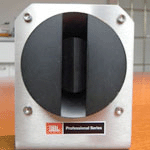
Originally Posted by
speakerdave

I don't know? I'm really not the one to be your cabinet tuning consultant, but . . . . where did this "best" tuning come from?
Is that JBL's tuning?
Isn't JBL's tuning 32 Hz? I thought you wanted to replicate the original.
How many ports does your duct length assume?
Here is the source:
Courbe de réponse, FB et Fréquence de coupure à -3 dB :
| Définition |
Paramètre |
Valeur |
Formules de calcul |
| Volume bass-reflex |
VB |
256.0 L |
Volume de calcul |
| Coeficient de volume |
N |
4.02 |
VB/(VAS*Qtsb2) |
| Optimisation de la courbe de réponse |
Opt |
FB est forcé à 24.9 Hz |
| FB pour 256.0 L |
FB |
24.9 Hz |
Précision du calcul à 0.1 dB |
| Niveau à 24.9 Hz |
EFB |
-8.8 dB |
Niveau à FB |
F à -3 dB pour 256.0 L
( En champs libre, donc dehors ) |
F-3 dB |
37 Hz |
Chapitre enceinte bass-reflex
Arrondi au dB le plus proche |
F à -6 dB pour 256.0 L
( Niveau à -3 dB dans votre salon ) |
F-6 dB |
29 Hz |
| F à -12 dB pour 256.0 L |
F-12 dB |
21 Hz |
| F à -24 dB pour 256.0 L |
F-24 dB |
13 Hz |
Courbe de réponse en champs libre du JBL 2235H, VB = 256.0 L, FB = 24.9 Hz, le 0 dB correspond à 100.0 dB/2.83V/m.
Rouge : Réponse en champs libre. Bleu : Réponse avec car gain.
Vert : Correction Hi-FI embarquée ou Room gain. Pente : 0.00 dB/octave en dessous de 0 Hz.

Of course i want to replicate the original, but i have to resolve the event problem..so i use mathematic to do that..





 Reply With Quote
Reply With Quote




